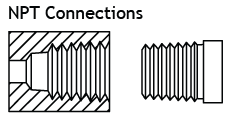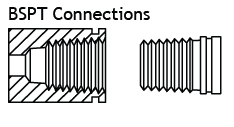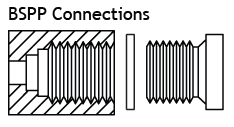Pressure systems in the process industry use different ways of sealing depending on the geographical region, size of the pressure system and the environment. There are regional differences in sealing types as well as industry preferences.
For example, many pressure systems onboard ships use BSPP adapters while many applications in the oil and gas industry use NPT fittings. While one sealing style is not inherently better than another each style has its application.
NPT Connections
NPT (National Pipe Thread) seals are the most popular type of seal for pressure calibration systems in the U.S. and Canada. NPT male adapters have a taper thread that wedges into the female NPT adapter. They seal due to the “out of roundness principle” which means that the male stretches the female fitting until there is so much force that the connection can hold pressure.

One of the challenges with this design is that if you connect stainless steel to stainless steel then over-tightening or poor lubrication can cause galling and damage to the threads. Thread sealant is needed to seal but only 2 turns of thread sealant is required.
Any more than that and the seal can leak around the thread sealant. Instruments has a wide variety of male NPT adapters , male Quick-disconnect NPT adapters,male NPT calibrator adapters, female NPT adapters, female NPT gauge adapters and female Quick-disconnect NPT gauge adapters.
BSPT Connections
BSPT (British Standard Pipe Thread) is similar to NPT except for one important difference. The angle across the flanks of threads (if you sliced the fitting in half long-ways and measured the angle from root to crest to root) is 55 degrees instead of 60 degrees as it is for NPT. Thus an NPT male will fit into a BSPT fitting or vice versa but they will not seal.

This is a popular fitting in China and Japan but is very rarely used in North America unless the equipment to which it is attached was imported. Thread sealant is needed to seal the male and female fitting together. Instruments has adapters to both male BSPT adapters and female BSPT adapters.
BSPP Connections
BSPP (British Standard Parallel Pipe) is most popular in the UK, Europe, Asia, Australia, New Zealand and South Africa. It is a parallel thread fitting that uses a bonded seal ring to do the sealing. This bonded ring seal is sandwiched in-between a shoulder on the male fitting and the face of the female fitting and is squeezed in place.

BSPP pressure gauges have a longer male thread and use a copper crush washer that is squeezed in between the bottom of the male fitting and the bottom of the female BSPP hole forming a pressure tight seal. No thread sealant is needed to form a seal. Instruments has male BSPP adapters , female BSPP adapters, female BSPP gauge adapters, and female BSPP Quick-disconnect gauge adapters.
Also Read: Basics of Control Valves
What is the difference between BSPP, BSPT and NPT Fittings?
BSP, NPT, BSPP, BSPT – All these different standards can be very confusing!
What is the difference?
The differences depend on several factors:
1.Geographical Region
2.Industry
3.Environment
4.Application etc…
NPT :
NPT stands for National Pipe Thread and is the standard used by the US and Canada.
NPT fittings angle cross threads are at 60 degrees and they have flattened peaks and troughs.
There can be some confusion as the tapered thread is referred to as NPT (National Pipe Taper) the straight version is NPS (National Pipe Straight). There are also a couple of variations NPLTF National pipe taper fuel and NPSM National pipe straight mechanical just to confuse things even more. These are designed to provide more leak free seals without using sealants. They are the same shape but have adjusted crest and root heights.
The male adaptors have taper threads that fit into the female adaptors forming a seal when twisted together. Tapered fittings are used mainly on the ends of pipes, nipples and fitting such as couplings, elbows and tees.
NPS parallel threads need gaskets or O-rings to seal them.
BSP :
This stands for British Standard Pipe and is the standard used internationally by the UK, Europe, Asia and Australia.
They are similar to the NPT but have angle cross threads of 55 degrees and have rounded peaks and valleys.
These are divided into BSPT for tapered threads and BSPP for parallel threads. BSPT fittings require sealants whereas the BSPP use banded seal rings to seal fittings in between the shoulder on the male and the face of the female and do not require sealants.
Can they be used together?
Most definitely NOT. These fittings should never be mixed as this can lead to leakage and can be dangerous.
When would you use one or the other?
If you are using anything that is made in the US or Canada then NPT fittings should be used. If your equipment is made anywhere else in the world then you should use BSP fittings.